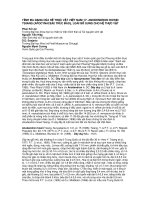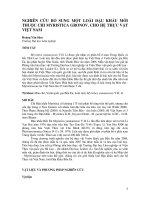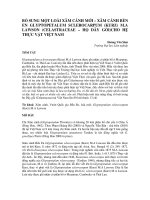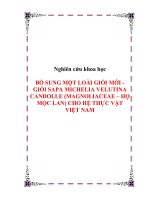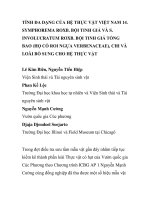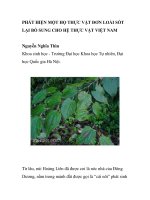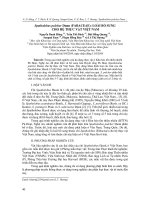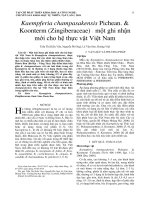Cynanchum insulanum (Hance) Hemsl. (Apocynaceae, Asclepiadoideae): MỘT LOÀI BỔ SUNG CHO HỆ THỰC VẬT VIỆT NAM
Bạn đang xem bản rút gọn của tài liệu. Xem và tải ngay bản đầy đủ của tài liệu tại đây (457.87 KB, 4 trang )
<span class='text_page_counter'>(1)</span><div class='page_container' data-page=1>
<i>Trần Thế Bách và Đtg </i> Tạp chí KHOA HỌC & CƠNG NGHỆ 187(11): 39 - 42
39
<i><b>Cynanchum insulanum (Hance) Hemsl. (Apocynaceae, Asclepiadoideae): </b></i>
<b>A NEW RECORD TO THE FLORA OF VIETNAM </b>
<b>Tran The Bach1, 2, Do Van Hai1, Bui Hong Quang1 </b>
<b>Sy Danh Thuong3, Ha Minh Tam4, Bui Thu Ha5*</b>
<i>1</i>
<i>Institute of Ecology and Biological Resources - VAST </i>
2
<i>Graduate University of Science and Technology - VAST, </i>
<i>3 </i>
<i>TNU - University of Education, 4Hanoi University of Education 2, </i>
<i>5</i>
<i>Hanoi National University of Education</i>
SUMMARY
<i>The genus Cynanchum L. comprises approximately 200 species mainly distributed in southern </i>
Asia, Africa, Europe, North and South America. Based on references of J. Costantin (1912), P.T.
<i>Li et al. (1995), Pham Hoang Ho (2003), Tran The Bach (2005), Tran The Bach & Vu Xuan </i>
Phuong (2004), Tran The Bach (2017) and www.theplantlist.org (10 July 2018), 5 species of
<i>Cynanchum were recorded in Vietnam: C. corymbosum Wight, C. officinale (Hemsl.) Tsiang & </i>
<i>H.T. Zhang, C. utriculosum Costantin, C. stauntonii (Decne.) Schltr. ex H.Lév., C. verticillatum </i>
<i>Hemsl… In this study, species Cynanchum insulanum (Hance) Hemsl. (Apocynaceae, </i>
<i>Asclepiadoideae) is confirmed as a new record for flora of Vietnam. It is described, illustrated. A </i>
<i>key to Cynanchum species of Vietnam is established. The species is morphologically most similar </i>
<i>to C. utriculosum in having peduncle, pedicel glabrous and caudicle <80 µm long. However, the </i>
species can be differentiated from flower bud 1.8-2.4 mm long and caudicle >40 µm long.
Specimens of the species were collected in Bach Long Vi island (Hai Phong Province) and have
<b>been kept at Herbarium of Institute of Ecology and Biological Resources (HN). </b>
<i><b>Keywords: Cynanchum insulanum, Sat khuyen dao, Bach Long Vi, Hai Phong, Vietnam</b></i>
INTRODUCTION*
The genus <i>Cynanchum </i> L. comprises
approximately 200 species [2]. This genus
can be distinguished from other genera of
Apocynaceae in having characteristics: anther
2-celled, pollens aggregate into pollinia,
outside of pollinium with wall, pollinium
pendulous, translator with caudicles, corona
simple, cup-shaped and corona lobes united.
<i>In Vietnam, 5 species of Cynanchum were </i>
<i>recorded: C. corymbosum Wight, C. officinale </i>
(Hemsl.) Tsiang & H.T. Zhang, <i>C. </i>
<i>utriculosum Costantin, C. stauntonii (Decne.) </i>
<i><b>Schltr. ex H.Lév., C. verticillatum Hemsl. [1], </b></i>
[3], [4], [5], [6], [7]. The study of herbarium
specimens collected in the Bach Long Vi
island (Hai Phong Province, Vietnam)
<i>allowed us to identify a new record of </i>
<i>Cynanchum to the flora of Vietnam, it is </i>
<i>Cynanchum insulanum (Hance) Hemsl.. </i>
MATERIAL AND METHODS
*
<i>Tel: 0949 844646; Email: </i>
<b>Materials: Specimens of all species of </b>
<i>Cynanchum in Vietnam stored in herbaria. </i>
<i>Specimens of C. insulanum (Hance) Hemsl. </i>
were studied at HN herbarium of Department
of Botany, Institute of Ecology and Biological
Resources, Vietnam Academy of Science and
Technology.
<b>Methods: The morphologically compared </b>
method is used to study. It is the suitable
method in this study.
RESULTS AND DISCUSSION
<i><b>Key to species of Cynanchum in Vietnam </b></i>
1A. Liana.
2A. Peduncle, pedicel haired. Caudicle > 100
µm long .
3A. Fruit densely and conspicuously setose.
Caudicle > 130 µm long.
<b>... </b>
<i><b>... 1. C. corymbosum </b></i>
</div>
<span class='text_page_counter'>(2)</span><div class='page_container' data-page=2>
<i>Trần Thế Bách và Đtg </i> Tạp chí KHOA HỌC & CÔNG NGHỆ 187(11): 39 - 42
40
2B. Peduncle, pedicel glabrous. Caudicle <
<b>80 µm long. </b>
4A. Flower bud 1.8-2.4 mm long. Caudicle >
40 µm long ...
...
<i><b> ... 3. C. insulanum </b></i>
4B. Flower bud 5-7 mm long. Caudicle < 35
<i><b>µm long ... 4. C. utriculosum </b></i>
1B. Plant erect
5A. Corolla lobe 0.6-1 mm wide.
Follicles ≥ 9 cm long ...
<i><b> ... 5. C. stauntonii </b></i>
5B. Corolla lobe 2-2.5 mm wide.
Follicle ≤ 5 cm long ………..
<i><b> ….……….6. C. verticillatum </b></i>
<b>Taxonomic treatment: </b>
<i><b>Cynanchum insulanum (Hance) Hemsl. – </b></i>
<b>Sát khuyển đảo </b>
Hemsl. J. Linn. Soc., Bot. 26(173): 107.
1889; P. T. Li & al. Fl. China 16: 213. 1995.
Lianas, to 0.6 m or more. Stem glabrous
except for pubescent nodes; internodes 16-33
mm long, ca. 1 mm in diameter. Petiole 1-21
mm long, 0.4-0.8 mm diam., glabrous. Leaves
opposite, leaf blade triangular-cordate to
linear-lanceolate, 0.7-4 cm long, 0.6-2 cm
wide; glabrous; base cordate, basal lobes
rounded; apex acuminate; lateral veins 2-6
paired. Inflorescences umbel-like,
4-6-flowered; peduncle 12-13 mm long, 0.71-1.19
mm in diam., glabrous. Flower bud ovate,
elliptic, 1.8-2.4 mm long, 1.08-1.30 mm wide.
Flowers white- greenish; pedicel 3.81-5.16
mm long, 0.22-0.36 mm in diam., glabrous.
Bract triangular-lanceolate, 0.7-1.69 mm
long. Sepals lanceolate-triangular, greenish,
with 5 basal glands; gland oblong, 0.33 mm
long, 0.08 mm wide; sepal tube 0.75 mm
long; sepal lobes glabrous, 1-1.86 mm long,
0.5-0.77 mm wide. Corolla rotate, glabrous,
ca. 3.2 mm in diameter; corolla tube
0.36-0.78 mm long; corolla lobes 5,
ovate-lanceolate, lanceolate-oblong, 2-2.32 mm
long, 0.79-1 mm wide, white. Corona inserted
at base of gynostegium, cupular, glabrous,
with adaxial appendages; corona tube 2.05
mm long, 1.62 mm wide; appendages 5,
oblong, 1.21 mm long, 0.38 mm wide.
Anthers with membranous apical appendages;
appendages ovate, 0.41 mm long, 0.29 mm
wide. Pollinia 2 per pollinarium, pendulous,
spoon-shaped, 290-390.3 µm long, 90-141.8
µm wide; corpusculum oblong, 181-186.3 µm
long, 70-83.3 µm wide; caudicles 2 per
pollinarium, 49.1-51.4 µm long, 34.9-40 µm
wide. Ovary bi-carpellate, 0.72 mm long, 0.3
mm wide, glabrous; stigma urceolate-shaped,
0.75 mm long, 0.52 mm wide, apex
pentagonal, 0.18-0.20 mm in diameter.
<b>Loc. class.: China: Hainan: to 100 m. Typus: </b>
BM001014197 (BM).
<b>Flowering season: July. </b>
<b>Distribution: China (Guangdong, Guangxi, </b>
Hainan), Vietnam (Hai Phong: Bach Long Vi).
<b>Specimens examined: Vietnam. Hai Phong </b>
province: Bach Long Vi island, 9 July 2014,
BTL 66 (HN).
CONCLUSION
1. Building the key to distinguish
<i>Cynanchum insulanum (Hance) Hemsl. from </i>
other species of Cynanchum in Vietnam. It is
a new record to the flora of Vietnam.
2. The morphological characteristics and
<i>related information of C. insulanum have </i>
been described including loc.class., typus,
flowering season, distribution, research
specimen, figure, color photographs.
<b>Acknowledgments </b>
Funding for this research was provided by
NAFOSTED 106.03-2017.08 and project
“Bioprospecting on Biological Materials of
Vietnam” VONO01.03/18-18.
</div>
<span class='text_page_counter'>(3)</span><div class='page_container' data-page=3>
<i>Trần Thế Bách và Đtg </i> Tạp chí KHOA HỌC & CƠNG NGHỆ 187(11): 39 - 42
41
<i><b>Figure 1. Cynanchum insulanum (Hance) Hemsl.: 1. Habitat; 2. Flowering branch; 3. Inflorescence; 4. </b></i>
<i>Pollinarium (Photographs by Do Van Hai & Tran The Bach) </i>
<i><b>Figure 2. Cynanchum insulanum (Hance) Hemsl.: 1. Flowering branch; 2. Corona; 3. Pollinarium; 4. </b></i>
</div>
<span class='text_page_counter'>(4)</span><div class='page_container' data-page=4>
<i>Trần Thế Bách và Đtg </i> Tạp chí KHOA HỌC & CƠNG NGHỆ 187(11): 39 - 42
42
REFERENCES
<i>1. Costantin J., (1912), “Asclépiadacées”, Flore </i>
<i>Générale de L’Indo-Chine, Masson et Cie, Paris, </i>
4(1), pp. 1–154.
2. Li P.T., Gilbert M. G., Stevens W. D., (1995),
<i>“Asclepiadaceae”, In: Wu, Z. Y. & Raven, P. H. </i>
<i>(eds.) Flora of China, Science Press, Beijing & </i>
<i>Missouri Botany Garden Press, St. Louis, 16, pp. </i>
189–270.
<i>3. Pham Hoang Ho (2003), “Asclepiadaceae”, An </i>
<i>Illustrated Flora of Vietnam, Young Publishing </i>
<i>House, Ho Chi Minh, Vietnam, 2, pp. 724–755. </i>
<i>4. Tran The Bach, (2005), “Asclepiadaceae”, In: </i>
<i>Ban, N. T. (ed.) et al., Checklist of plant species of </i>
<i>Vietnam, </i> Vietnamese Academy Science
Technology, Missouri Botany Garden & Hanoi
National University, Agricuture. Publishing
House, Hanoi, 3, pp. 58–75.
5. Tran The Bach, (2017), “Cynanchum”,
<i>Asclepiadaceae R. Br., Flora of Vietnam, </i>
<i>Publishing House for Science and Technology, 15, </i>
<i>pp. 260-269. </i>
6. Tran The Bach, Vu Xuan Phuong, (2004), “A
new record of genus Cynanchum L.
<i>(Asclepiadaceae) for flora of Vietnam”, Journal </i>
<i>of Biology, 26, (4A), pp. 42-43. </i>
7. www.theplantlist.org (10 July 2018).
TÓM TẮT
<i><b>Cynanchum insulanum (Hance) Hemsl. (Apocynaceae, Asclepiadoideae): </b></i>
<b>MỘT LOÀI BỔ SUNG CHO HỆ THỰC VẬT VIỆT NAM </b>
<b>Trần Thế Bách1, 2, Đỗ Văn Hài1, Bùi Hồng Quang1 </b>
<b>Sỹ Danh Thường3, Hà Minh Tâm4, Bùi Thu Hà5* </b>
<i>1<sub>Viện Sinh thái và Tài nguyên sinh vật -Viện Hàn lâm Khoa học và Công nghệ Việt Nam </sub></i>
<i>2<sub>Học viện Khoa học và Công nghệ - Viện Hàn lâm Khoa học và Công nghệ Việt Nam, </sub></i>
<i>3<sub>Trường Đại học Sư phạm – ĐH Thái Nguyên, </sub>4<sub>Trường Đại học Sư phạm Hà Nội II, </sub></i>
<i>5<sub>Trường Đại học Sư phạm Hà Nội </sub></i>
<i>Chi Cynanchum L. gồm khoảng 200 loài phân bố chủ yếu ở nam châu Á, châu Phi, châu Âu, bắc </i>
và nam Mỹ. Trước nghiên cứu này, trên cơ sở tham khảo các tài liệu J. Costantin (1912) , P.T. Li
<i>et al. (1995), Phạm Hoàng Hộ (2003), Trần Thế Bách (2005), Trần Thế Bách & Vũ Xuân Phương </i>
(2004), Trần Thế Bách (2017) và www.theplantlist.org (cập nhật ngày 10 tháng 7 năm 2018), 5
<i>loài của chi Cynanchum đã được ghi nhận ở Việt Nam là C. corymbosum Wight, C. officinale </i>
<i>(Hemsl.) Tsiang & H.T. Zhang, C. utriculosum Costantin, C. stauntonii (Decne.) Schltr. ex H.Lév., </i>
<i>C. verticillatum Hemsl.. Trong nghiên cứu này, loài Cynanchum insulanum (Hance) Hemsl. </i>
(Apocynaceae, Asclepiadoideae) được khẳng định là ghi nhận mới cho hệ thực vật Việt Nam. Loài
<i>này đã được mơ tả, minh họa bằng hình vẽ và ảnh. Khóa định loại các lồi của chi Cynanchum ở </i>
<i>Việt Nam đã được xây dựng. Lồi có đặc điểm hình thái giống nhất với lồi C. utriculosum vì có </i>
cuống cụm hoa, cuống hoa nhẵn và chiều dài chuôi của cơ quan truyền phấn ngắn hơn 80 µm. Tuy
<i>nhiên, loài này phân biệt với C. utriculosum bởi nụ hoa dài 1,8-2,4 mm và chuôi của cơ quan </i>
<i>truyền phấn dài hơn 40 µm. Mẫu tiêu bản của lồi C. insulanum được thu thập tại đảo Bạch Long </i>
Vĩ, thành phố Hải Phòng và hiện nay được lưu giữ tại Phòng tiêu bản (HN) thuộc Viện Sinh thái
<b>và Tài nguyên sinh vật. </b>
<i><b>Từ khóa: Cynanchum insulanum, Sat khuyen dao, Bach Long Vi, Hai Phong, Vietnam </b></i>
<i><b>Ngày nhận bài: 08/8/2018; Ngày phản biện: 18/8/2018; Ngày duyệt đăng: 31/10/2018 </b></i>
*
</div>
<!--links-->
